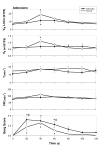The pulmonary effects of intravenous adenosine in asthmatic subjects
- PMID: 17137511
- PMCID: PMC1693563
- DOI: 10.1186/1465-9921-7-139
The pulmonary effects of intravenous adenosine in asthmatic subjects
Abstract
Background: We have shown that intravenous adenosine in normal subjects does not cause bronchospasm, but causes dyspnea, most likely by an effect on vagal C fibers in the lungs [Burki et al. J Appl Physiol 2005; 98:180-5]. Since airways inflammation and bronchial hyperreactivity are features of asthma, it is possible that intravenous adenosine may be associated with an increased intensity of dyspnea, and may cause bronchospasm, as noted anecdotally in previous reports.
Methods: We compared the effects of placebo and 10 mg intravenous adenosine, in 6 normal and 6 asthmatic subjects.
Results: Placebo injection had no significant (p > 0.05) effect on the forced expiratory spirogram, heart rate, minute ventilation (Ve), or respiratory sensation. Similarly, adenosine injection caused no significant changes (p > 0.05) in the forced expiratory spirogram; however, there was a rapid development of dyspnea as signified visually on a modified Borg scale, and a significant (p < 0.05) tachycardia in each subject (Asthmatics +18%, Normals + 34%), and a significant (p < 0.05) increase in Ve (Asthmatics +93%, Normals +130%). The intensity of dyspnea was significantly greater (p < 0.05) in the asthmatic subjects.
Conclusion: These data indicate that intravenous adenosine does not cause bronchospasm in asthmatic subjects, and supports the concept that adenosine-induced dyspnea is most likely secondary to stimulation of vagal C fibers in the lungs. The increased intensity of adenosine-induced dyspnea in the asthmatic subjects suggests that airways inflammation may have sensitized the vagal C fibers.
Figures
References
-
- Biaggioni I, Olafsson B, Robertson RM, Hollister AS, Robertson D. Cardiovascular and respiratory effects of adenosine in conscious man. Evidence for chemoreceptor activation. Circ Res. 1987;61:779–786. - PubMed
-
- Rankin AC, Brooks R, Ruskin JN, McGovern BA. Adenosine and the treatment of supraventricular tachycardia. Am J Med. 1992;92:655–66. - PubMed
-
- Burki NK, Dale WJ, Lee L-Y. Intravenous adenosine and dyspnea in man. Journal of Applied Physiology. 2005;98:180–185. - PubMed
-
- Guidelines for the diagnosis and management of asthma. Expert panel report 2. NIH Publication No. 97–4051. 1997.
Publication types
MeSH terms
Substances
Grants and funding
LinkOut - more resources
Full Text Sources
Medical


